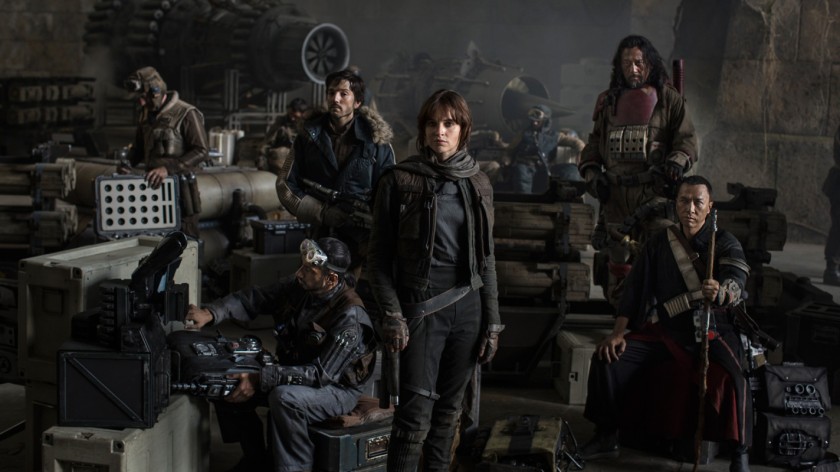
Star Wars: A Rogue One Story official cast photo
Yes, it’s true. Star Wars was once a white world, one filled with albeit weird creatures, but still very white.
When Star Wars: A New Hope ushered a new era of science-fiction movies in 1977 it featured an all-white cast (James Earl Jones, despite being the voice of Darth Vader was never seen on-screen). It took until the first sequel, Empire Strikes Back (1980), to see a person of color in the franchise, the beloved Lando Calrissian (portrayed by Billy Dee Williams).
By contrast, Star Wars in 2016 features a different face, and a remarkably multicultural one at that. There was a time when Star Wars seemed almost out of reach if you weren’t white, it is no longer the case.
If race in cinema really wasn’t an issue, we wouldn’t be discussing it. Our current reality shows us differently. Hollywood is still this all too white territory where racial barriers continue to persist, unfortunately.
As proven by the #oscarssowhite movement (where many expressed their discontent at the apparent whiteness displayed by the Oscars), audiences everywhere are thirsty for cultural diversity. Rogue One: A Star Wars Story is more than happy to quench that thirst.
Last year’s The Force Awakens featured John Bogeya in the role of Finn, a black man, as one of its lead characters. Many applauded Disney for this move. But featuring diverse ethnicities in movies isn’t bold or daring anymore, it’s a no brainer in this day and age. After all, shouldn’t art and entertainment be all-inclusive and therefore be reflective of our culture? And More importantly, does it matter? Yes, and again, yes.
A multicultural cast has mass appeal. As such it is able to reach a larger demographic and touch significantly more lives. It’s what art is supposed to do. Gone are the days where only white people played in Star Wars. Hey, it’s a start.
OK—white British actress Felicity Jones is technically the star of Rogue One, but with a cast that feature Mexican actor Diego Luna, Chinese actors Donnie Yen and Jiang Wen, British-Pakistani actor Riz Ahmed and African-American actor Forrest Whitaker— it’s culturally rich. Star Wars in the 2010s has evolved to reflect diversity and it’s beautiful. Rejoice.
I attended a conference with Dr. Reza Aslan earlier this year and he summed up race and diversity in popular-culture as follows:
“When shown diverse ethnicities in media like television and movies they become a part of popular-culture. People just see it over and over to the point where it becomes ordinary, it becomes a part of their everyday lives,” he explained.
Now I’m not suggesting the work is done by any means, and we have ways to go, but in this age of Trump a movie like Rogue One is refreshing. A movie the size of Star Wars could be an enormous boost when it comes to including more diverse ethnicities on the big screen.

Starwars.com
Rogue One: A Star Wars Story detaches itself from the mold of tradition in the movie’s first minute by ditching the iconic scrolling text that begun every entry in the franchise thus far. I hear you. Geeky cries of “How dare they?” and “Blasphemy!” are heard everywhere in a galaxy far, far away.
If there’s anything Star Wars fans expect, it’s tradition. Rogue One is anything but. Star Wars dishes another healthy dose of nostalgia, but isn’t content to simply thread on old ground. It takes a heroic war movie approach without abandoning its space opera roots. It certainly had its space in the continuum of the franchise. It’s a Star Wars movie, but it’s a clearly different Star Wars.
Here’s where it gets confusing: Rogue One is a sequel to the prequels (I-III), but a prequel to the sequels (IV-VI) —its events unfolding between episodes III and IV—it also ties in with The Force Awakens and answers some unanswered questions about the beloved sci-fi saga. Confused yet? It’s essentially a side Star Wars movie not meant to be a part of the current VII-IX trilogy, but rather to be taken in as a stand-alone film. It’s a new concept in the Star Wars universe and one that effectively display potential for the following stand-alone stories to come in the series.
The film holds the dubious distinction of being harder to follow than perhaps any other entry in the Star Wars cannon, largely due to its odd placement in the saga. The brand new characters also play a part in this equation. Seasoned fans will understand the events occurring in the movie, but the casual moviegoers following the hype will likely get lost in the story. In this regard, Rogue One is directed towards hardcore fans and less so the newer ones it amassed from The Force Awakens, Disney is not at the point where it cashes-in. At least not yet.
In case you’re wondering, there are plenty of Easter eggs to keep fans on the edge of their seats. Blink and you’ll miss a brief R2-D2 and C3PO appearance and that’s just to name one.
Is Rogue One: A Star Wars Story worth seeing? Absolutely. With a jaw-dropping appearance by Darth Vader that will no doubt send legions of fans into hysterics all across the galaxy, rich visuals, a compelling story and an array of Easter Eggs, it is definitely worth the price of admission.
The movie’s climatic ending is as satisfying as it is heart-wrenching and necessary. In spite of box office performance and overwhelmingly positive reception by critics and fans alike, I have a feeling Rogue One’s ultimate achievement and legacy will be what it did to promote cultural diversity in Hollywood.
Believe the hype.
“The force is with me, I am the force.”—Chirrut Îmwe
Tommy this is one of the best non-spoiler writeups I have read. Well done!
LikeLike
High compliment! Thank you Mike 🙂
LikeLiked by 1 person